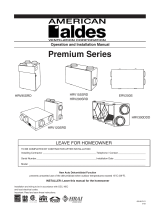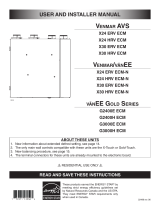Bryant ERVCRNVA is an Energy Recovery Ventilator (ERV) that brings fresh air into your home while expelling stale air, helping to reduce indoor air pollution and improve air quality. It operates continuously when your thermostat is set to the constant fan mode and requires no adjustments or changes by the homeowner. The ERV's washable filters should be cleaned every three months, and the core should be vacuumed every three months when the outdoor temperature is between 60°F (16°C) and 75°F (24°C).
Bryant ERVCRNVA is an Energy Recovery Ventilator (ERV) that brings fresh air into your home while expelling stale air, helping to reduce indoor air pollution and improve air quality. It operates continuously when your thermostat is set to the constant fan mode and requires no adjustments or changes by the homeowner. The ERV's washable filters should be cleaned every three months, and the core should be vacuumed every three months when the outdoor temperature is between 60°F (16°C) and 75°F (24°C).


-
 1
1
-
 2
2
Bryant ERVCRNVA Owner's manual
- Type
- Owner's manual
- This manual is also suitable for
Bryant ERVCRNVA is an Energy Recovery Ventilator (ERV) that brings fresh air into your home while expelling stale air, helping to reduce indoor air pollution and improve air quality. It operates continuously when your thermostat is set to the constant fan mode and requires no adjustments or changes by the homeowner. The ERV's washable filters should be cleaned every three months, and the core should be vacuumed every three months when the outdoor temperature is between 60°F (16°C) and 75°F (24°C).
Ask a question and I''ll find the answer in the document
Finding information in a document is now easier with AI
Related papers
Other documents
-
FIELD CONTROLS FC95HRV. User manual
-
Fantech SER150 Installation guide
-
 American Aldes Premium HRV300DDD Operation and Installation Manual
American Aldes Premium HRV300DDD Operation and Installation Manual
-
Venmar K7 ERV User guide
-
Carrier HRVCCSHB1100 User manual
-
Lifebreath METRO 120ERVD-ECM Owner's manual
-
Air King AKEV Series User manual
-
 Venmar X24ERV ECM User guide
Venmar X24ERV ECM User guide
-
Lifebreath 170 ERVD Owner's manual
-
Fantech SER 3204D Installation guide



